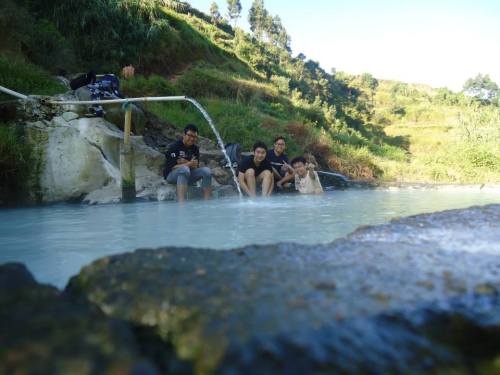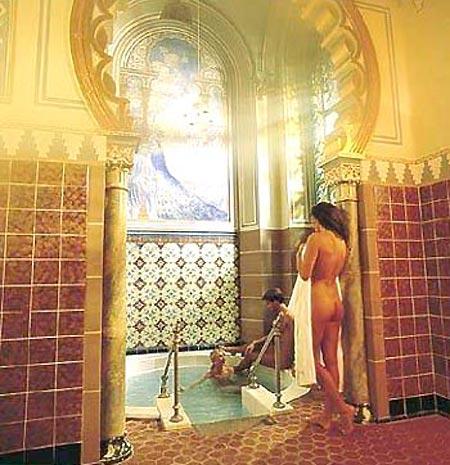'#throwback #sunday #hotspring #emeraldpool #aonang #bff'
Taken in Klongthom, Krabi, Thailand. Source
The northern hemisphere is slowly becoming colder; the time of year to seek the heat of mother earth herself.
It's also time to recap the year.
Little original content has been added to this site itself; such is life. But the regular updates besides capturing some pan-Asian soaking highlights seems gradually evolving into a number of themes:
- geothermal power development versus local soaking rights
- excessive development of hot springs
- (traditional) bathing traditions
- innovative ways of using earth heat
On other related sites, this year have seen their own developments. The Himalaya site has seen a number of original posts reworked and kept up-to-date. In this and the Thailand site have seen a number of photo posts.
Most of the effort though, has been directed to the Europe site, with a good number of original posts culminating in an overview of supposedly Europe's most natural soaks. Possibly the European Natural Soaking Society may well become the flag-bearing site. My own time for long-distance travel is very limited and the few remaining really natural soaking sites remaining in Europe may well need my fullest attention ...
Fiesta
But back on subject. The hot spring season in North (and Southeast?) Asia is under way.
With a couple photo's of models (or sexy girls as this website believes) chinatraveltips notes:
'The 6th China Huangshan Mountain international hot spring culture festival kicked off on November 18, 2013'.
Hot spring culture = couple of female models splashing?
Another hot spring festival, this time in Fuzhou - Lianjiang, China. Originally from China Daily (Oct. 30). What does a festival look like:
Southeast Asia lagging in this party (thankfully?)?'The guests enjoyed dance and singing performances from Russia, Spain, Taiwan and Fuzhou, and also had the opportunity to relax at the hot springs at Gui’an Xishan resort hotel after the show'.
Follow the leader
The Jakarta Post (Nov. 6) describes the Philippines as an example to follow in the field of geothermal power:
'Indonesia does not have to look very far to find the best way to tap geothermal energy, which potentially is located in protected, remote forests.As Indonesia struggles to find a balance between the development of geothermal resources, forest conservation, and development, the Philippines has shown how that can be achieved....Agnes de Jesus, senior vice president for environment and external relations at the Energy Development Corporation — the Philippines’ largest geothermal power producer — recalled similar challenges in 1988 when the Philippine government decided to build geothermal power plants in the middle of Mount Apo Natural Park following the El Nino weather phenomenon that reduced hydropower generation.The plan was highly controversial at that time, de Jesus said, citing the lack of legal basis to establish plants in a conservation area, which is also an ancestral domain for indigenous people.“We conducted scientific surveys on the site to asses the environmental impact and held many consultations with stakeholders to explain about the project,” she said. It took four years for the project to start after securing approval from indigenous people and a presidential decree that granted exploitation permits in the forested area'.
The example is thus an example in the way government appeases investors. But with energy dependency as the winner.
More news (Indonesia-investments.com, Oct 22) for potential investors in Indonesia's geothermal power. A law is actually being drawn up concerning development of geothermal energy. This would be an improvement as currently geothermal power falls under mining laws.
More news (Indonesia-investments.com, Oct 22) for potential investors in Indonesia's geothermal power. A law is actually being drawn up concerning development of geothermal energy. This would be an improvement as currently geothermal power falls under mining laws.
Harking on this is an earlier article in the Jakarta Globe (Oct. 27). It explains the intricacies of a geothermal project in Lampung, Sumatra:
'Locals should be consulted on the development of the geothermal power plant being planned near Mount Rajabasa in South Lampung regency so that it will not spark controversy and be rejected by indigenous people living in the surrounding areas, a minister has said'.
A Turkish company has shown interest in geothermal power nearby (Republika, Oct. 26). And then the Jakarta Globe also reports (Oct. 7) on Japanese investment in Indonesia's geothermal power.
So it looks like geothermal power generation in Indonesia is gathering steam.
So it looks like geothermal power generation in Indonesia is gathering steam.
Meanwhile, the typhoon which struck so devastatingly central Philippines, also affected the Leyte geothermal power generation. This article (interaksyon, Nov. 19) mentions 4 power stations affected with capacity potential of over 600 MW. though since, some have been reactivated.
Coincident or not CNN's money has 3 minute highlight on exactly Leyte.
Coincident or not CNN's money has 3 minute highlight on exactly Leyte.
Culture II
Over the past months Thailand has seen it's great public debate: are the many Chinese tourists a bane or boon?
'The National Tourism Administration publicised its 64-page Guidebook for Civilised Tourism - with illustrations to accompany its list of dos and don'ts - on its website ahead of a "Golden Week" public holiday that started on Tuesday. ...!!!! Nice.
It also urged them not to occupy public toilets for long periods of time or leave footprints on the toilet seat. Nor should they urinate in swimming pools'.
The northern Thai city of Chiang Mai sees the brunt of of the
Chinese influx; it forms the backdrop to a popular tv comedy in
China. But the Lanna citizens are not all happy (Bangkok Post, Oct. 13):
'But despite the large sums of money these tourists bring, many local business owners complain about the travellers' uncouth behaviour _ spitting on the street, failing to flush the toilet, pushing in and any number of messy dining habits'.
The article rolls out a complete gambit
of every possible problem the Chinese are the source of. This involves
the above but also low spending culture, BYO, poor driving, extensive
haggling, etc. Thankfully no reports from local hot springs ... As of yet.
Than the Bangkok Post reports
on October 25 on the nearly 100% increase in tourists from China. The
arguments contra are for instance that the Chinese guests hardly spend any money as most of
the souvenirs available in Thailand are made in China! Inappropriate
behaviour is another argument. Example provided:
'I have some first-hand experience of Chinese manners. During a stay in a Pattaya hotel, I saw a group of Chinese tourists, who were walking back from the beach, stop by the hotel's swimming pool to wash their feet. Needless to say, this upset the swimmers'.
Well, next year will probably see another flavour: Indians? Americans? Rwandi? What will the complaints be then?
And totally different. Japan thinks that soaking is passè. The answer (Reuters, Nov. 23) to keeping towns dependent on their hot springs is to open casinos!
And totally different. Japan thinks that soaking is passè. The answer (Reuters, Nov. 23) to keeping towns dependent on their hot springs is to open casinos!
'In contrast to the massive resorts of Las Vegas and Singapore, aspiring hosts outside the big cities are looking to the more compact facilities of Europe as a guide.
The German spa town of Baden-Baden, which also has casinos, is serving as a model for casino proponents in two traditional hot springs towns - Atami, in Shizuoka Prefecture, and Naruto, in southwestern Japan's Tokushima Prefecture'.
Asian affairs
- Indonesia
A blog features a beautiful look at the highlands of Bali.
This includes a walk to Angseri hot spring.
Source: heyitsksh.
This includes a walk to Angseri hot spring.
Source: heyitsksh.
Another find? Tinggi Raja, North Sumatra was visited by the Green family (Nov 7). Is it soakable? Possibly too hot!
Jeff Low has a photographic feature on Manggaruda, hot spring, Flores, Indonesia (Oct. 24). Here's just one of the photo's:
A good report (bygetupandleave,
Sep. 11) on climbing Rinjani volcano, Lombok, Indonesia. Note the
ability to take a soak after the climb near the crater rim. And the
photo's:
The amazing hot spring!
- Malaysia
An extensive report (The Star, Nov. 16) to the little disturbed forests of Ulu Meda in Kedah, Malaysia:
'How can a vacation ever be complete without a trip to the hotsprings? Indeed, after a five minute boat ride upstream, Hymeir led us into a place called Sira Ayer Hangat, which literally meant Hot Water Salt Lick. He guided us into a shallow stream, pointing out safe spots to step as certain spots had hot scalding water! Downstream, the hot spring water mixed with the cooler river to created a perfectly warm swimming area.On a sandbar in the middle of the stream, steam rose from the ground. A wispy white substance coated the areas where hot water from a hidden spring wept straight from the sands into the surrounding stream'.
Sira Ayer Hangat literally means ‘Hot Water Salt Lick’. It’s frequented by wildlife.
It continues:
'... once, a visiting government official saw the area and thought of turning it into a commercialised spa. Fortunately, this didn’t come to pass as it would not only have damaged the environment, but also would have driven the animals away. Besides, there were hot springs nearer towns outside the Ulu Muda conservation area'.
Hurrah!
Lest some forget, the Borneo Post (Nov. 17) mentions the existence of a hot spring in it's own backyard, Panchor Dayak:
Lest some forget, the Borneo Post (Nov. 17) mentions the existence of a hot spring in it's own backyard, Panchor Dayak:
'There is one in our own backyard – Panchor Hot Spring, nestled in lush secondary jungle at Kampung Panchor Dayak, Mile 27, along the old Kuching-Serian Road.
Here, one can enjoy the invigorating effects of a natural hot spring without having to travel thousands of miles or paying a huge sum for it.
...
In terms of facilities, Panchor Hot Spring offers quite the minimaL. There is a main wooden structure housing a canteen, a sitting place, shower rooms as well as toilets. From here, a wooden plank walk leads to the pools with a natural ambiance.
What can be easily overlooked is perhaps is the totally green jungle backdrop where tropical animals and birds may sometimes be spotted.
During a recent visit, I spotted two different types of birds — a green-whitish one which winged down a tree but soared skyward almost instantly in one swift motion, and a blue-greyish pair which fluttered among some fallen branches towards the bushes, lingering long enough for their pictures to be taken'.






















